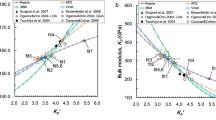Abstract
One of the main uncertainties in mineralogical models of the Earth's lower mantle is the nature of the aluminous mineral: it is not clear whether Al forms its own minerals or is mainly contained in (Mg,Fe)SiO3-perovskite. This question is very important, since it is known that if Al were mainly hosted by perovskite, it would radically change Fe/Mg-partitioning and phase equilibria between mantle minerals, and also alter many physical and chemical properties of perovskite, which is currently believed to comprise ca. 70% of the volume of the lower mantle. This, in turn, would require us to reconsider many of our geochemical and geophysical models for the lower mantle. This work considers the possibility of a V3O5-type structured modification of Al2SiO5 to be the main host of Al in the lower mantle, as proposed by previous workers. We report ab initio calculations, based on density functional theory within the generalised gradient approximation (GGA) with plane wave basis set and nonlocal pseudopotentials. We consider polymorphs of Al2SiO5 (kyanite, andalusite, sillimanite, and hypothetical V3O5-like and pseudobrookite-like phases), SiO2 (stishovite, quartz) and Al2O3 (corundum). Computational conditions (e.g., plane-wave energy cutoff, Brillouin zone sampling) were carefully chosen in order to reproduce small energy changes associated with phase transitions between the Al2SiO5 polymorphs. Good agreement of crystal structures, bulk moduli, atomisation energies and the phase diagram of Al2SiO5 with experimental data was found. Strong disagreement between the calculated lattice parameters and density of V3O5-like phase of Al2SiO5 and experimental values, assigned to it by previous workers, suggests that a V3O5-structured phase of Al2SiO5 was never observed experimentally. In addition, we found that the most stable high-pressure assembly in Al2SiO5 system is corundum+stishovite, and the value of the transition pressure at T = O K (113 kbar) is in excellent agreement with experimental estimates (95–150 kbar). We explain the instability of octahedrally coordinated silicates of Al to decomposition on the basis of Pauling's second rule.
Similar content being viewed by others
Author information
Authors and Affiliations
Additional information
Received: 18 May 1999 / Accepted: 5 November 1999
Rights and permissions
About this article
Cite this article
Oganov, A., Brodholt, J. High-pressure phases in the Al2SiO5 system and the problem of aluminous phase in the Earth's lower mantle: ab initio calculations. Phys Chem Min 27, 430–439 (2000). https://doi.org/10.1007/s002699900081
Issue Date:
DOI: https://doi.org/10.1007/s002699900081



